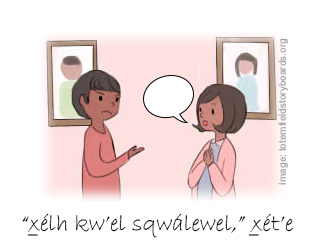“X̲élh kw’el sqwálewel,” x̲ét’e means ‘”I’m sorry”, she says’.
Literally it means ‘My thoughts/feelings hurt, says (she)’.
‘She’ is not explicitly stated, and is just understood from context. In other contexts, the same sentence could be interpreted as ‘…he says’, or some other contextually defined person.
Vocabulary
- x̲élh – feel hurt
- kw’el – my (the more common form is tel. Kw’el implies more remoteness or gives a sense that you are talking about something possible
- sqwálewel – thoughts, feelings
- x̲ét’e – to say
Audio: Elizabeth Herrling
Structure notes
The structure of this phrase is as follows:
As noted above, there is no explicit word for ‘she‘ in this sentence, but this is understood from context.
You could also say “X̲élh kw’el sqwálewel”, x̲ét’e thútl’o, where thútl’o means ‘she‘ or ‘her‘. However, Elders commonly do not explicitly state the person doing the action, and just have you understand it from context.



No comments yet.